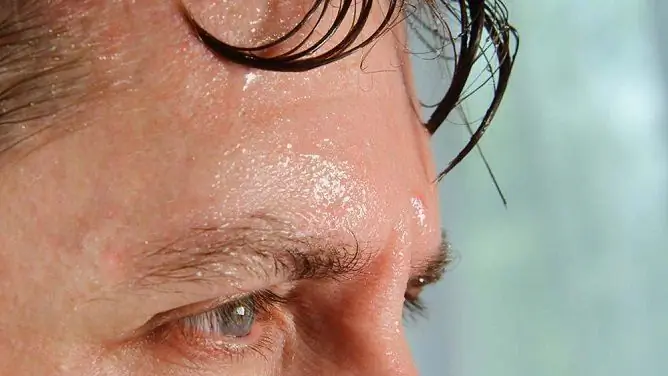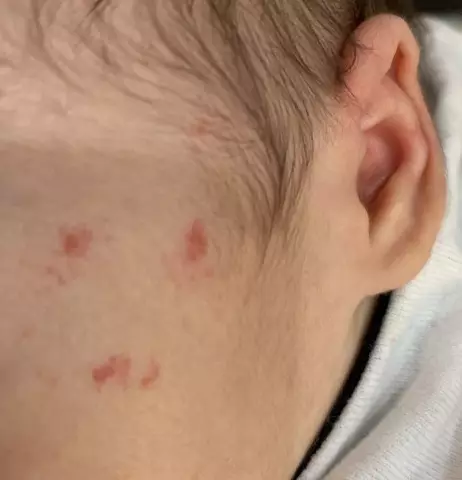- Author Rachel Wainwright [email protected].
- Public 2023-12-15 07:39.
- Last modified 2025-11-02 20:14.
Deprive children
The content of the article:
- Causes and risk factors
- Forms of the disease
- Symptoms of lichen in children
- Diagnostics
- Lichen treatment in children
- Possible complications and consequences
- Forecast
- Prevention
Deprive in children is a generalized name for an extensive group of skin diseases provoked by fungi (mycoses) and viral agents, which are characterized by various lesions of smooth skin and scalp, less often - nail plates, mucous membranes.
Some types of the disease occur mainly in adulthood, some in all age categories. Deprive in children develops, as a rule, due to the peculiarity of the composition of the secretion of the sweat and sebaceous glands, which contains an insufficient amount of chemicals that perform the function of protective factors.
Deprive in children under one year old is quite rare; children from 1-3 to 14-15 years old are more susceptible to the disease. Despite a wide range of pathological conditions, united by the term "lichen", only a few of them are characteristic of children.

Symptoms of lichen in children
Causes and risk factors
Depending on the form, the cause of the disease can be pathogenic or opportunistic fungi, viruses.
Infection occurs through direct tactile contact with a sick animal or when using common household items with an infected person, exchanging clothes and hats with him. The source of infection can also be bedding or things that contain wool, particles of the skin of a sick animal, personal hygiene items used by an infected person. In the case of the viral nature of the disease, the transmission of the pathogen occurs from a sick person to a healthy airborne droplet.
The majority of cases of lichen in children are caused by the following fungi:
- Trichophyton rubrum;
- Trichophyton tonsurans;
- Trichophyton mentagrophytes;
- Microsporum canis;
- Microsporum aureum;
- Pityrosporum orbiculare;
- Pityrosporum ovale;
- Malassezia furfur.
The viruses that most often provoke the development of lichen in children are herpes viruses type 6 or 7, but their role in the formation of the disease has not been fully understood.

Shingles infection most often occurs by contacting children with sick animals
For the development of lichen in children, additional exposure to risk factors that weaken the local and general resistance of the body is necessary:
- autoimmune diseases;
- postponed acute infectious processes;
- the presence of chronic pathology of various systems and organs;
- hypothermia;
- exposure to acute stress factors (change of the familiar environment, adaptation to a preschool institution, medical manipulations, etc.);
- vaccination;
- hereditary predisposition;
- insufficient level of personal hygiene of the child; etc.
Forms of the disease
The main forms of lichen:
- pink (Gibert's disease);
- shearing;
- shingles (herpes zoster);
- pityrious;
- red flat.
The manifestations of this disease also include psoriasis (scaly lichen) and eczema (weeping lichen), however, the complexity of clinical manifestations and the multiplicity of causative factors do not allow unambiguously classifying these pathologies as varieties of lichen.
Lichen in children is most often found in the form of ringworm, pink or pityriasis.
Despite the fact that lichen planus occurs in all age categories, the peak incidence occurs at the age of 30 to 60 years, children are extremely rare.
Shingles, or herpes zoster, is triggered by a virus that causes chickenpox, also known as chickenpox. After infection, the child develops a disease that is resolved by the formation of persistent lifelong immunity (this is the reason for a single incidence of chickenpox). However, the herpes zoster virus, which is the cause of chickenpox, continues to persist in the body, migrating to the nerve ganglia, where it exists in an inactive state until the moment provoking factors are exposed to the body. Against the background of adverse effects on the body, the virus is activated and moves along the processes of peripheral nerves to the epithelial cells, where it causes specific symptoms of herpes zoster (herpes). Thus, the likelihood of developing this form of lichen in children is extremely small,it occurs most often in adulthood, rather even in old age, in persons who have had chickenpox.
Symptoms of lichen in children
Regardless of the form, the signs of lichen in children have a number of similar features:
- incubation (latent period) from several days to several weeks from the moment of infection;
- the presence of skin defects of various colors, shapes and severity;
- peeling, skin rashes;
- hair loss.
Features of ringworm on a child's head:
- in the first days (rarely weeks) after infection, there is no symptomatology, the only sign of the disease is hair damage in the immediate vicinity of the scalp (white plaque, resembling a cover, enveloping the base of the hair shaft);
- changes in the structure of the hair (dry, brittle, easily pulled out of the follicles);
- lesions (bald spots) are single or multiple, more often of small size - up to 5 cm (small foci of dropout are possible near the main defect with a diameter of up to 1-1.5 cm), isolated, rounded, covered with "stumps" of broken hair, when trying to smooth damaged fragments of hair, they do not take their original position, but remain deflected in one direction or another;
- a peculiar smell ("mouse" or "barn") from the lesions.
The main manifestation of smooth skin ringworm is the presence of rounded defects of varying intensity of staining (from pink to bright red), rising above the level of intact skin, which arise at the site of contact with the pathogen. In the future, the center of the plaque falls off, turns pale, becomes covered with scales, a ridge-like eminence forms along the periphery, and the defect takes the form of a ring.
Features of pityriasis versicolor in children:
- predominant localization on the upper body (this form of lichen is often found on the face of a child);
- multiple spots from pink-red to dark brown (hence the second name of the disease is versicolor versicolor), small in size, with clear boundaries, prone to merging into larger foci;
- the affected areas are not sunburned, remain light against the background of darkened skin;
- slightly pronounced peeling of spots;
- lack of inflammation.

Pink lichen in a child
Specific features of pink lichen in children:
- general malaise preceding skin manifestations (headache, unmotivated weakness, joint and muscle pain, rise in body temperature to subfebrile numbers);
- the debut of skin manifestations with the formation of a rounded maternal single plaque of bright pink color, more often in the upper part of the body, after a few days it shrivels, darkens and becomes covered with pityriasis scales in the center;
- the appearance of multiple flaky elements within 7-10 days after the formation of the maternal spot (mainly on the lateral surfaces of the body, neck), the paroxysmal appearance of new foci, especially after water procedures;
- preservation of skin defects for up to 4-5 weeks, after which there is a spontaneous spontaneous resolution of the disease.
Diagnostics
In order to diagnose lichen in children, an objective examination, collection of anamnesis, instrumental methods are used:
- luminescent study of previously cleaned lesions under a Wood's lamp (a characteristic glow is noted);
- microscopy of hair fragments or scales collected from the surface of skin defects;
- cultural research (bacteriological inoculation of particles of biological material on a nutrient medium).
Lichen treatment in children
The approaches to the treatment of various forms of lichen in children are similar:
- antimycotic local drugs in the case of a fungal nature of the disease, with ineffectiveness, use multicomponent creams, ointments, including hormonal and antimicrobial components;
- in severe cases, taking systemic antifungal antibiotics;
- local drying agents (on demand);
- vitamin and mineral complexes;
- local antiseptics in case of trauma to skin defects, when weeping;
- immunostimulants;
- antihistamines.
Treatment of lichen in children in case of Gibert's disease, as a rule, is not performed, since the disease tends to resolve on its own.

The treatment of lichen in children is mainly carried out using local remedies.
At the time of therapy, a number of requirements must be observed:
- hypoallergenic diet;
- regular change of bed and underwear;
- limiting prolonged contact of skin rashes with water;
- limiting contact with other children.
Possible complications and consequences
Deprive in children can cause the following complications:
- accession of a secondary infection;
- irreversible patchy baldness (ringworm);
- chronicity of the disease.
Forecast
With timely diagnosis and complex treatment, the prognosis is favorable.
Prevention
- Avoiding tactile contact of a child with street animals.
- Monitoring the health of a pet if it has access to an open environment.
- Refusal to share hygiene items, clothing, hats.
- The earliest possible isolation of the child in case of suspected illness, immediate medical attention.
- Periodic preventive examinations in places of permanent or temporary stay of children.
- Restorative measures: balanced diet, adequate exposure to fresh air, moderate regular physical activity, etc.
YouTube video related to the article:

Olesya Smolnyakova Therapy, clinical pharmacology and pharmacotherapy About the author
Education: higher, 2004 (GOU VPO "Kursk State Medical University"), specialty "General Medicine", qualification "Doctor". 2008-2012 - Postgraduate student of the Department of Clinical Pharmacology, KSMU, Candidate of Medical Sciences (2013, specialty "Pharmacology, Clinical Pharmacology"). 2014-2015 - professional retraining, specialty "Management in education", FSBEI HPE "KSU".
The information is generalized and provided for informational purposes only. At the first sign of illness, see your doctor. Self-medication is hazardous to health!






